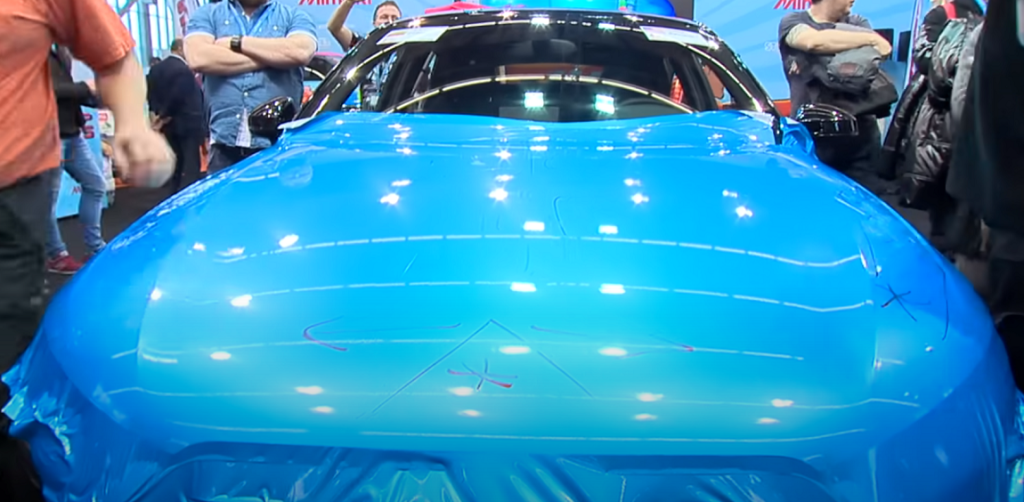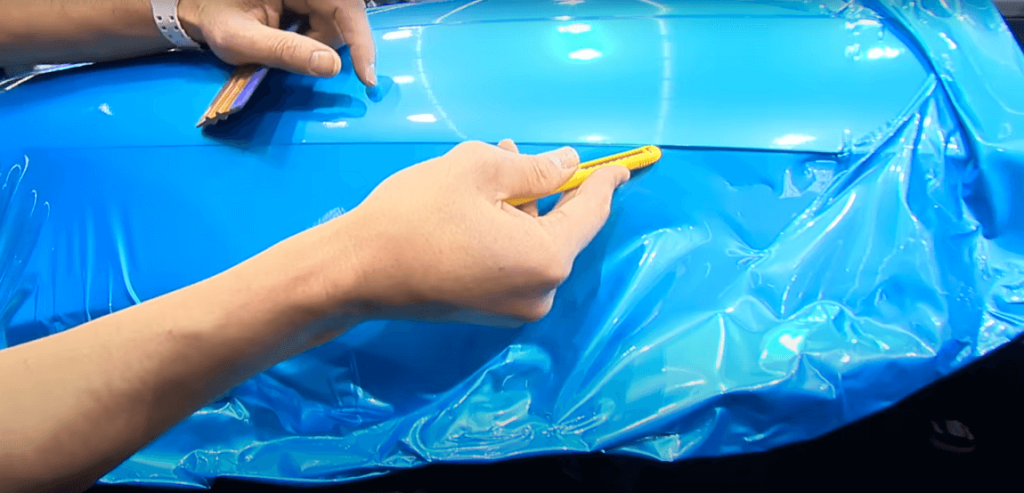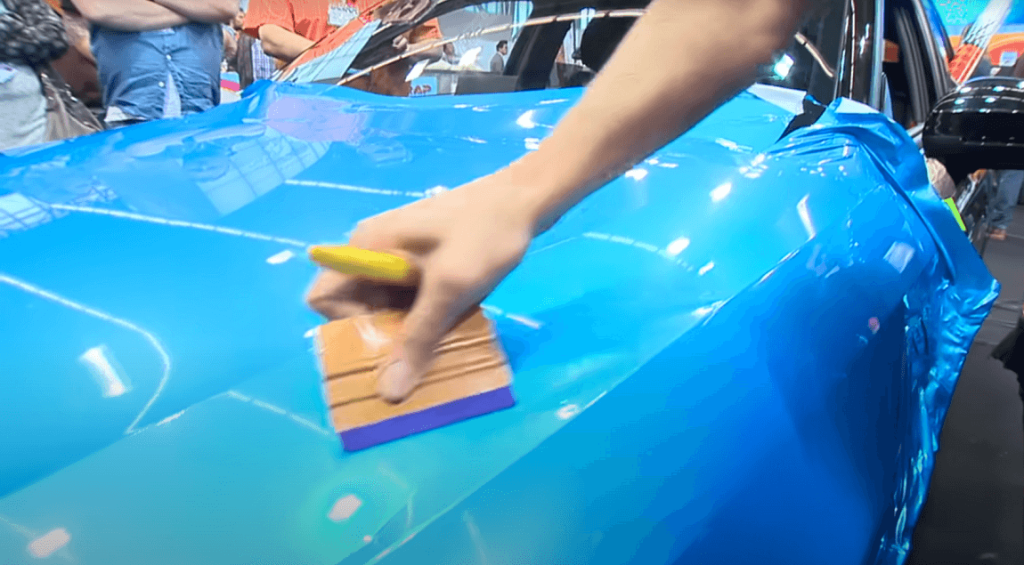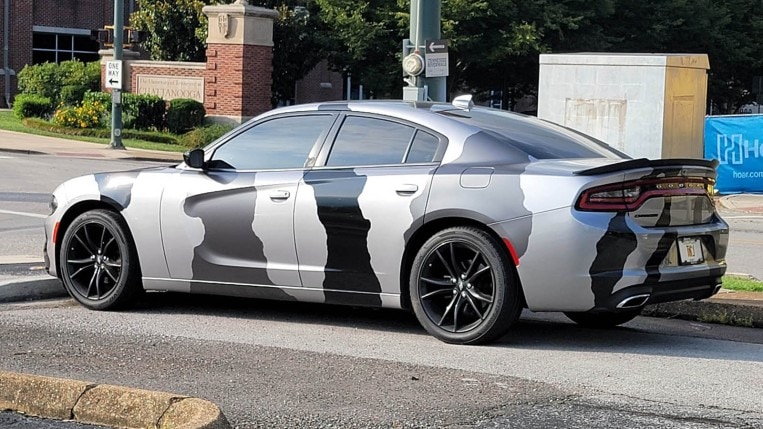This article was updated in August 24, 2023 with new products and information by Mark S. Taylor
To wrap your car, first clean the surface thoroughly. Then, apply the vinyl wrap gradually, smoothing out any air bubbles as you go.

Contents
The Benefits Of Car Wrapping
Enhancing Your Vehicle’S Appearance
Car wrapping is a fantastic way to give your vehicle a fresh, eye-catching look. Here are some ways it can enhance your vehicle’s appearance:
- Instantly transform your car: Car wraps come in a wide variety of colors, patterns, and finishes. From vibrant solids to attention-grabbing designs, you can choose a wrap that perfectly matches your style and personality. Whether you want a sleek and sophisticated matte finish or a bold and striking pattern, car wrapping allows you to customize your car’s appearance with ease.
- Stand out from the crowd: With car wrapping, you have the opportunity to turn heads wherever you go. A unique and eye-catching wrap will make your vehicle instantly noticeable on the road. Whether you’re driving through the city or parked at a car show, a well-designed car wrap will give your vehicle that extra wow factor.
Protecting your car’s paintwork
Beyond its aesthetic benefits, car wrapping also serves as a protective layer for your vehicle’s paintwork. Here’s how car wrapping can help safeguard your car’s exterior:
- Shield against scratches and chips: The vinyl material used in car wraps provides an extra layer of protection against minor scratches and chips. It acts as a barrier, shielding your car’s original paint from everyday wear and tear, such as road debris and stone chips. This means that your car’s paintwork will remain in pristine condition, preserving its long-term value.
- Preserve resale value: By protecting your car’s paintwork with a car wrap, you can maintain its resale value. A well-preserved exterior is a significant factor for potential buyers when considering a used vehicle. With a car wrap, you can ensure that your car’s paintwork stays in top-notch condition, increasing its appeal and value when the time comes to sell.
Cost-Effective Option For Style Upgrades
Car wrapping not only enhances your car’s appearance and protects the paintwork but also provides a cost-effective option for style upgrades. Here’s why car wrapping is an economical choice:
- Change your car’s look without a full respray: A full vehicle respray can be expensive and time-consuming. Car wrapping, on the other hand, offers a more budget-friendly alternative to completely change the look of your car. With a professionally applied car wrap, you can achieve a stunning transformation without the need for extensive paintwork.
- Protect your investment: Car wrapping is a cost-effective way to protect your car’s original paintwork and avoid costly repairs in the future. By investing in a car wrap, you’re not only upgrading the style of your vehicle but also ensuring its long-term durability. The cost of a car wrap is significantly lower compared to potential paintwork repairs, making it a smart financial decision.
- Easy removal and reversibility: One of the major benefits of car wrapping is that it is easily removable. If you decide to change your car’s color or revert back to its original paintwork, the vinyl wrap can be professionally removed without causing any damage. This flexibility allows you to experiment with different styles and colors over time, keeping your car’s appearance fresh and exciting.
Car wrapping offers a multitude of benefits, from enhancing your car’s appearance and protecting its paintwork to providing an affordable option for style upgrades. With its versatility and cost-effectiveness, it’s no wonder that car wrapping has become increasingly popular among car enthusiasts.
So, why not give your vehicle a whole new look and enjoy the advantages that car wrapping has to offer?

Step-By-Step Guide To Car Wrapping
Car wrapping is an innovative way to transform the look of your vehicle, protect its paintwork, and create a unique statement on the road. Whether you’re looking to advertise your business or simply want to give your car a fresh new appearance, wrapping it with vinyl is a cost-effective and versatile solution.
In this step-by-step guide to car wrapping, we will walk you through the entire process, from preparing your vehicle to caring for your wrapped car. So let’s dive in and learn how to wrap your car like a pro!
Preparing Your Vehicle For Wrapping:
Before you start the car wrapping process, you need to ensure that your vehicle is in the best condition for a seamless installation. Here are the crucial steps for preparing your vehicle:
- Cleaning and decontaminating the surface: Thoroughly wash your car to remove any dirt, grime, or debris. Use a clay bar to remove any embedded contaminants on the surface.
- Removing any existing decals or stickers: Take off any old decals or stickers from your car. Use a heat gun or hair dryer to soften the adhesive and carefully peel them off.
- Repairing damaged areas: Inspect your car for any dents, scratches, or chipped paint. Repair these areas before proceeding with the wrapping process to ensure a smooth and flawless finish.
Choosing The Right Wrapping Material:
Selecting the right vinyl wrapping material is essential for achieving the desired look and durability. Consider the following factors when choosing your wrapping material:
- Exploring different types of vinyl wraps: There are various types of vinyl wraps available, such as colored vinyl, textured vinyl, or carbon fiber vinyl. Research and choose the one that suits your preferences and needs.
- Considering colors, finishes, and patterns: Decide on the color, finish, and pattern of the vinyl wrap that will best enhance the appearance of your car. Whether you prefer a glossy finish or a matte one, there is a wide range of options to choose from.
Gathering The Necessary Tools And Equipment:
Having the right tools and equipment at hand will make the car wrapping process smoother and more efficient. Here are the essential tools you’ll need:
- Heat gun or hair dryer: These tools will help you warm up the vinyl wrap for easy stretching and conforming to the curves of your car.
- Trim removal tools: Use these tools to safely remove any exterior components, such as door handles, side mirrors, and emblems, to ensure optimal installation.
- Squeegee and air release tool: These tools are crucial for smoothing out the vinyl and removing air bubbles during the application process.
- Cutting tools and knifeless tape: Sharp cutting tools and knifeless tape will help you achieve precise cuts and edges without damaging your car’s paintwork.

Measuring And Cutting The Vinyl Wrap:
Proper measurement and cutting of the vinyl wrap are essential for a seamless installation. Follow these steps to ensure accuracy:
- Taking precise measurements: Use a measuring tape to measure each panel of your car that will be wrapped. Make sure to add some extra vinyl for proper coverage and trimming.
- Using a cutting mat and knife for accuracy: Utilize a cutting mat to protect your surfaces while cutting. Use a sharp knife to cut the vinyl wrap according to your panel measurements.
Applying The Vinyl Wrap:
Now comes the exciting part – applying the vinyl wrap to your vehicle. Follow these tips for a smooth and bubble-free installation:
- Starting with flat surfaces: Begin by wrapping the flat and easily accessible areas of your car. This will help you gain confidence and practice your wrapping technique.
- Working around curves and contours: When wrapping curved surfaces, apply gentle heat with a heat gun or hair dryer to help the vinyl wrap conform to the contours of your car.
- Using the right techniques for bubble-free application: Use a squeegee or air release tool to remove any air bubbles or wrinkles that may appear during the installation process.
Trimming And Finishing The Edges:
After applying the vinyl wrap, it’s time to trim and finish the edges for a polished look. Here’s what you need to do:
- Trimming excess vinyl: Use a sharp knife to trim the excess vinyl along the edges and seams of your car. Take your time and make precise cuts to achieve clean lines.
- Applying finishing touches for seamless results: Once the edges are trimmed, use a heat gun or hair dryer to warm up the edges slightly. Gently press them down for a seamless finish.
Caring For Your Wrapped Car:
To keep your wrapped car looking its best and prolong its lifespan, regular cleaning and maintenance are necessary. Follow these guidelines for proper care:
- Regular cleaning and maintenance: Wash your wrapped car regularly with a mild detergent and water. This will help remove any dirt or grime that may accumulate over time.
- Avoiding harsh chemicals and abrasive materials: Stay away from harsh chemicals, abrasive cleaners, and automatic car washes with brushes. They can damage the vinyl wrap and affect its appearance.
- Dealing with damaged or peeling areas: In case of any damage or peeling, address the issue promptly. Contact a professional car wrapping service provider to get expert help and advice.
By following this step-by-step guide to car wrapping, you’ll be able to transform the look of your car while protecting its paintwork. Remember to gather the necessary tools, choose the right wrapping material, and apply the wrap with precision and care.
With proper maintenance, your wrapped car will turn heads wherever you go. Happy car wrapping!
Common Mistakes To Avoid
Wrapping your car is an exciting project that can transform its appearance and give it a fresh, personalized look. However, if you’re new to car wrapping, it’s important to be aware of some common mistakes that can hinder the outcome of your project.
In this section, we will discuss the key mistakes that you should avoid when wrapping your car.
Rushing The Preparation Process
Proper preparation is the foundation of a successful car wrap. Many people make the mistake of rushing through the preparation process, which can lead to problems down the line. Here are some points to keep in mind:
- Thoroughly clean your car before applying the vinyl. Remove any dirt, debris, or wax from the surface to ensure a clean and smooth application.
- Take your time to inspect the car for any imperfections or damage. Addressing these issues before wrapping can prevent them from being visible under the vinyl.
- Use a lint-free cloth and an appropriate cleaning solution to remove any oils, fingerprints, or other contaminants that can affect the adhesion of the vinyl.

Applying The Vinyl Too Tightly Or Loosely
The application process is another crucial step when wrapping your car. Applying the vinyl too tightly or loosely can result in a less-than-desirable outcome. Consider the following:
- Apply the vinyl with even tension to avoid any wrinkles, bubbles, or creases. This ensures a smooth and professional finish.
- Avoid stretching the vinyl excessively, as this can lead to premature wear and tear or even cause it to fail over time.
- On the other hand, avoid applying the vinyl too loosely. Loose vinyl can result in unsightly sagging or peeling, especially in high-speed or windy conditions.
Ignoring Temperature And Weather Conditions
Temperature and weather conditions can have a significant impact on the quality and durability of your car wrap. Pay attention to the following factors:
- Choose a day with moderate temperature to apply the vinyl. Extreme heat or cold can affect the adhesive properties of the vinyl, making it difficult to apply or causing it to lift prematurely.
- Ideally, apply the vinyl in a controlled environment such as a garage or a covered area to prevent the vinyl from being exposed to direct sunlight, rain, or strong winds.
- If you must apply the vinyl outdoors, select a day with calm weather conditions and avoid installing it in direct sunlight.
Improper Removal Techniques
At some point, you may need to remove the car wrap, either to replace it or revert to the original paint job. Improper removal techniques can damage the paint or leave behind adhesive residue. Consider the following:
- Use heat to soften the vinyl before attempting to remove it. This can make the removal process easier and minimize the risk of damaging the paint.
- Use a plastic or rubber spatula to gently lift the edges of the vinyl. Avoid using sharp tools that can scratch the paint.
- If there is any adhesive residue left behind, use an adhesive remover specifically designed for automotive surfaces. Follow the manufacturer’s instructions to avoid damaging the paint.
By avoiding these common mistakes, you can achieve a professional-looking car wrap that not only enhances the aesthetics of your vehicle but also ensures its longevity. Take your time, follow proper techniques, and consult with professionals if needed to get the best results.
Happy wrapping!
Frequently Asked Questions About Car Wrapping
Car wrapping is a popular way to give your vehicle a fresh and unique look. Whether you want to add a personal touch or promote your business, vinyl wraps offer a cost-effective and temporary solution. However, before diving into the world of car wrapping, you may have some burning questions.
In this section, we will address frequently asked questions about car wrapping to help you make an informed decision.
How Long Does A Vinyl Wrap Last?
- A vinyl wrap typically lasts between 3 to 5 years, depending on various factors such as the quality of the vinyl, the climate of your location, and how well the wrap is maintained.
- Factors like exposure to harsh weather conditions, excessive sun exposure, and regular washing can affect the longevity of the wrap.
- It’s important to note that while the vinyl may start to show signs of wear and tear over time, it can still be removed without causing any damage to the underlying paintwork.
Can I Wash My Wrapped Car?
- Yes, you can definitely wash your wrapped car. In fact, regular cleaning is recommended to maintain the appearance of your wrap.
- However, it’s important to use a gentle touch and avoid harsh scrubbing or abrasive cleaning products that can damage the vinyl.
- Opt for a hand wash using a mild detergent or car wash solution, and avoid high-pressure washers or automated car washes with harsh brushes.
Can I Wrap A Car With Paint Damage?
- Yes, you can wrap a car with paint damage. In fact, one of the advantages of car wrapping is that it can act as a protective layer, preventing further damage to the paint.
- However, it’s essential to ensure that the surface is properly prepared before applying the wrap. Any loose paint or rust should be fixed and the surface should be smooth and clean to achieve the best results.
Can I Remove The Vinyl Wrap?
- Yes, vinyl wraps are designed to be removable without leaving any residue or damaging the original paintwork.
- It’s important to note that removing the wrap requires a delicate and precise process. If you’re unsure or uncomfortable doing it yourself, it’s recommended to seek professional assistance.
- When done correctly, the removal process should not affect the integrity of the underlying paint, allowing you to switch to a new wrap or restore the original look of your car.
Does Car Wrapping Affect Insurance?
- Generally, car wrapping does not affect your insurance coverage. However, it’s advisable to inform your insurance provider about the modification to ensure full coverage.
- Some insurance companies may require additional documentation or adjust the policy accordingly. It’s always better to be transparent to avoid any complications in the event of a claim.
Now that we’ve cleared up some common concerns about car wrapping, you can confidently explore this creative and customizable option to transform the look of your vehicle. Remember to choose a reputable professional or diy carefully, and enjoy the eye-catching results that a vinyl wrap can offer.
Choosing A Professional Car Wrapping Service
Car wrapping is a great way to give your vehicle a fresh, unique look while also protecting its original paint. However, to achieve the best results, it’s important to choose a professional car wrapping service that has the skills and expertise to handle the job.
Here are some key factors to consider when selecting a car wrapping service:
Researching And Checking Reviews
- Research different car wrapping service providers online to find ones that are reputable and reliable.
- Read customer reviews and testimonials to get an idea of their previous clients’ experiences.
- Look for reviews on independent platforms or social media to ensure authenticity.
- Pay attention to the overall rating and specific comments about the service quality, communication, and customer satisfaction.
Evaluating The Quality Of Previous Work
- Check the car wrapping service provider’s portfolio or gallery to see examples of their previous work.
- Look for clean, precise, and flawless installations.
- Assess the variety of vehicle types they have worked on to determine their versatility and expertise.
- Consider the overall creativity and attention to detail in their designs.
Requesting Detailed Quotes And Timelines
- Contact the car wrapping service providers you are interested in and request a detailed quote.
- The quote should include all aspects of the car wrapping project, such as materials, labor, and any additional services or customization.
- Ask for a breakdown of the estimated timeline, including the time required for design approval, preparation, and installation.
- Compare the quotes of different providers to ensure you are getting a fair price for the desired service.
Remember, choosing the right car wrapping service is crucial for achieving the desired outcome. By researching and checking reviews, evaluating the quality of previous work, and requesting detailed quotes and timelines, you can make an informed decision that will result in a professionally wrapped car that turns heads on the road.
Frequently Asked Questions Of How To Wrap Your Car
How Much Does It Cost To Wrap Your Car?
Wrapping a car can cost anywhere from $1,500 to $5,000, depending on the size and complexity of the vehicle. Factors such as the type of wrap material and design customization can also affect the cost. It’s best to get a quote from a professional wrap installer for an accurate estimate.
How Long Does A Car Wrap Last?
A well-maintained car wrap can typically last 5 to 7 years. However, the lifespan of a wrap can vary depending on factors such as exposure to sunlight, weather conditions, and how the vehicle is used. Regular cleaning and proper care can help prolong the longevity of the wrap.
Can You Wrap A Leased Car?
Yes, you can wrap a leased car. Car wraps can be easily removed without causing any damage to the vehicle’s original paint. This makes it a great option for leased cars, as the wrap can be taken off when the lease period ends, restoring the car’s original appearance and protecting it during the lease term.
Conclusion
Wrapping your car is an excellent way to give it a fresh new look and protect the original paint. By following the steps outlined in this blog post, you can achieve a professional-looking wrap that will turn heads on the road.
Take the time to properly clean and prep your car before starting, ensuring a smooth and seamless application. Remember to use high-quality materials to ensure durability and longevity. Whether you choose a full wrap or partial wrap, the options are endless.
From glossy finishes to vibrant colors, you can truly customize your vehicle to reflect your personality and style. Embrace the world of car wrapping and elevate your ride to the next level. Don’t be afraid to get creative and experiment with different designs.
So what are you waiting for? Get started on your car wrap journey today and enjoy the stunning results!

